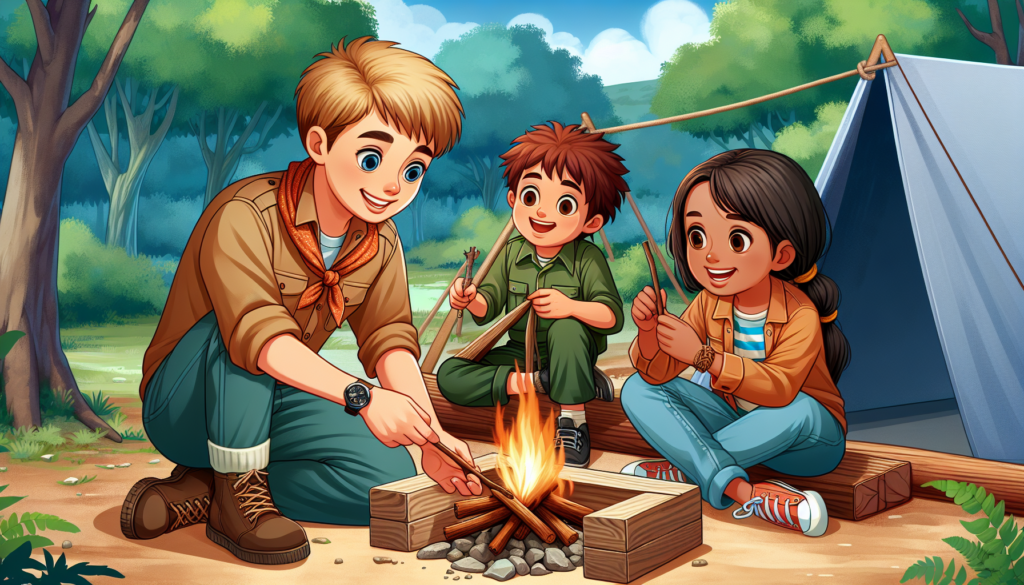In a world full of unexpected situations, it’s important to have the knowledge and skills to survive. That’s why teaching basic survival skills through fun and educational activities is so valuable. These activities cater to diverse audiences, from curious beginners to adventurous souls, and cover essential aspects like building shelters, finding water and food, staying warm, and signaling for help. By engaging in these activities, not only do you become more self-reliant and resilient, but you also gain the peace of mind knowing that you have the tools to overcome any challenge that comes your way. And even better, these activities can be enjoyed by children, making the learning experience both educational and enjoyable. So whether you’re preparing for an outdoor adventure or simply want to be equipped for life’s unpredictable twists, teaching basic survival skills through fun and educational activities is the way to go.
Introduction
In a world where unexpected situations can arise, mastering basic survival skills offers peace of mind and the potential to save lives. Whether you find yourself lost in the wilderness, facing urban disasters, or encountering life-threatening scenarios, having the knowledge and skills necessary to cope with emergencies is indispensable. Teaching basic survival skills has become increasingly important in today’s society, as it empowers individuals to become self-reliant and resilient in the face of adversity. This comprehensive article will explore the importance of learning basic survival skills, identify the target audience for teaching these skills, and provide a detailed guide to key survival techniques.
Importance of Teaching Basic Survival Skills
Why basic survival skills are crucial
Basic survival skills are crucial because they equip individuals with the necessary knowledge to handle emergency situations effectively. Whether you’re hiking in the mountains, exploring the wilderness, or even facing a natural disaster, having a foundation in survival skills can mean the difference between life and death. These skills empower you to overcome unforeseen circumstances, think critically, and make sound decisions in high-pressure situations.
Benefits of learning survival skills
Learning basic survival skills offers numerous benefits. Firstly, it enhances your self-confidence and self-reliance, knowing that you can rely on your own abilities to handle emergencies. Additionally, these skills foster a sense of resilience and adaptability, allowing you to navigate and overcome challenges effectively. Furthermore, learning survival skills can also deepen your connection with nature and increase your appreciation for the outdoors. By developing practical skills, you can forge a deeper bond with the natural world and gain a greater understanding of your place within it.

Target Audience for Teaching Basic Survival Skills
Curious beginners
Curious beginners who are interested in learning basic survival skills can greatly benefit from introductory education in this field. Whether it’s gaining knowledge about building shelters, finding water sources, or signaling for help, beginners can lay a solid foundation for their survival skillset by learning the basics. Engaging with this subject matter cultivates an understanding of self-sufficiency and ignites a curiosity for more advanced survival techniques.
Outdoor enthusiasts
For outdoor enthusiasts, from hikers to campers, learning basic survival skills is essential. Being out in nature exposes them to various risks and challenges, such as unpredictable weather conditions, getting lost, or encountering wildlife. Equipping themselves with the knowledge to build shelters, find water sources, procure food, and navigate emergencies ensures a safer and more enjoyable outdoor experience.
Families
Teaching basic survival skills to families is crucial for preparing them to handle emergencies together. In times of disaster or being stranded in the wilderness, knowing how to build shelters, find food and water, and maintain warmth can greatly increase the chances of survival for the entire family. Moreover, learning these skills as a family creates a sense of unity, trust, and preparedness, enhancing safety and peace of mind for all members.
Educational institutions
Integrating basic survival skills into educational institutions’ curricula provides students with valuable life skills. These skills go beyond the traditional academic subjects and cultivate resilience, resourcefulness, and problem-solving abilities. By incorporating survival skills into the educational framework, institutions empower students to face challenges head-on, fostering a sense of self-confidence and preparedness that will benefit them throughout their lives.
1. Building Shelters
Understanding different types of shelters
building shelters is a fundamental skill in survival situations. It involves understanding the various types of shelters and their appropriateness given the circumstances. Some common types of shelters include lean-tos, debris shelters, and tarp shelters. Each type offers different advantages and may be more suitable for specific situations.
Finding suitable materials
Once you understand the type of shelter you need, finding suitable materials in your surroundings is essential. Natural materials such as branches, leaves, and rocks can be used to construct shelters. Identifying the appropriate materials based on availability and durability is crucial for building a sturdy and reliable shelter.
Step-by-step shelter-building guides
To assist you in building shelters, step-by-step guides are available that outline the process in detail. These guides provide clear instructions and visuals to help you construct a shelter from start to finish. By following these guides, you can develop the necessary skills to build shelters efficiently and effectively in various survival scenarios.

2. Finding Water
Identifying potential water sources
Finding water is essential for survival, as the human body cannot function without it. Identifying potential water sources in your environment is crucial. These sources may include rivers, streams, lakes, or even natural depressions where water may collect. Understanding the signs and indicators of water presence can significantly increase your chances of finding a reliable water source.
Purifying water for safe consumption
Once you have located a water source, it is imperative to ensure its safety for consumption. purifying water eliminates harmful bacteria, viruses, and contaminants that may cause illness. Techniques such as boiling, using water filters, or chemical disinfection can be employed to purify water and make it safe for drinking.
Alternative methods of water collection
In situations where finding a natural water source is challenging, alternative methods of water collection can be employed. These methods include harvesting rainwater, condensation traps, and solar stills. Employing these alternative methods can help you obtain water even in arid environments or situations where access to water sources is limited.
3. Procuring Food
Foraging for edible plants
In survival situations, foraging for edible plants can provide a sustainable source of food. Learning to identify edible plants in your environment is crucial for avoiding toxic plants and ensuring your safety. This skill involves understanding plant characteristics, seasonal availability, and knowing how to properly prepare and consume wild edibles.
Hunting and fishing techniques
For those with a more advanced skillset, hunting and fishing techniques can provide additional sources of nourishment. Learning how to construct traps, set snares, and fish using a variety of methods enhances your ability to procure food in a sustainable and ethical manner.
Tips for food preservation
Once you have procured food, knowing how to preserve it is essential for long-term survival. Techniques such as smoking, dehydrating, and utilizing natural preservatives can help extend the shelf life of food. Learning these preservation techniques ensures that you have a stable source of sustenance during extended survival situations.
4. Staying Warm
Creating fire without matches
Fire is not only crucial for providing warmth but also for cooking food, boiling water, and providing a psychological boost. Learning how to create fire without matches using techniques such as friction (e.g., bow drill or hand drill), flint and steel, or using a magnifying glass empowers you to start a fire even in adverse conditions.
Building effective insulation
To maintain warmth in cold environments, building effective insulation is vital. This involves constructing insulating barriers between yourself and the ground or surrounding elements. Utilizing natural materials such as leaves, pine needles, or even snow can provide insulation and minimize heat loss.
Choosing appropriate clothing
In survival situations, the right clothing plays a critical role in staying warm and protected. Understanding layering techniques, choosing appropriate fabrics, and wearing weatherproof garments can help regulate body temperature and prevent hypothermia. By selecting clothing suitable for different weather conditions, you can ensure comfort and protect yourself from the elements.
5. Signaling for Help
Using visual signals
Signaling for help is essential when stranded or in a distressing situation. Visual signals, such as creating smoke, using mirrors or reflective surfaces, and setting up signal flags, can attract the attention of potential rescuers. Understanding how to create and utilize these signals can significantly increase the chances of being noticed and rescued.
Auditory signals for communication
In scenarios where visual signals may not be effective, auditory signals can be used for communication. Techniques such as blowing a whistle, yelling, or using sound-producing objects can alert nearby individuals or search parties to your presence. Learning these auditory signaling methods can be crucial in situations where visibility is low or obstructed.
Using technology for distress signals
Advancements in technology have provided additional tools for distress signaling. Carrying personal locator beacons (PLBs) or using mobile devices equipped with GPS and emergency beacon capabilities can help pinpoint your location and send distress signals to rescue authorities. Familiarizing yourself with these technologies and their operation can greatly enhance your chances of swift rescue.
6. Teaching Basic Survival Skills to Children
Importance of educating children about survival skills
Teaching basic survival skills to children is essential as it equips them with the knowledge and confidence to navigate emergency situations. By instilling these skills from a young age, children can develop a sense of self-reliance and preparedness. Additionally, this education fosters critical thinking, problem-solving abilities, and resilience, helping children build the foundation for a well-rounded skillset.
Age-appropriate teaching methods
When teaching survival skills to children, it is crucial to use age-appropriate teaching methods. Breaking concepts down into easily understandable and relatable terms, utilizing hands-on activities and games, and incorporating storytelling can engage children and make the learning experience enjoyable. By adapting teaching methods to suit their age and cognitive abilities, children can grasp and retain these skills more effectively.
Engaging and interactive activities for children
Engaging children in interactive activities is an effective way to teach survival skills while making the learning process enjoyable. Activities such as building shelters in the backyard, identifying edible plants during nature walks, or creating fire using safe materials can impart practical knowledge and engage children in hands-on learning. These activities promote curiosity, self-confidence, and a sense of empowerment in children.
Conclusion
Mastering basic survival skills is not only practical but also empowering. From building shelters and finding water to procuring food and signaling for help, these skills equip individuals to navigate emergency situations effectively and increase their chances of survival. By teaching basic survival skills to curious beginners, outdoor enthusiasts, families, and integrating them into educational institutions, we can empower individuals to become self-reliant, resilient, and prepared for life’s unpredictable twists. So, whether you’re gearing up for an outdoor adventure or simply seeking peace of mind, investing time in learning and practicing these skills ensures that you have the knowledge and capability to overcome challenges and emerge stronger.

